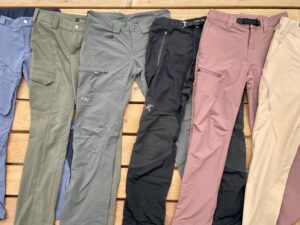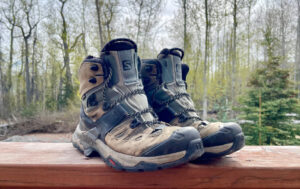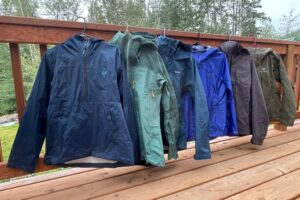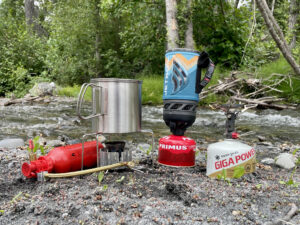Your climbing harness is arguably the most important piece of gear you will buy as a climber. And it’s probably one of the first things you’ll buy if you’re just getting into climbing (unless you’re just into bouldering).
But whether this is your first harness or your fifteenth, you’re looking for help for a reason. Maybe you want to know what’s new on the market, find some personal feedback on a new type of harness, or maybe you just don’t know where to start.
Whatever you’re looking for, our guide to the best climbing harnesses includes models that I have personally tested, as well as others I have experience with through friends and climbing partners. From lightweight sport climbing harnesses to comfortable climbing harnesses that you can hang in all day, there’s something for everyone on this list.
The best climbing harness
Best all-around harness: Petzl Luna Harness

- Lots of padding
- Split webbing harnesses
- Five gear loops
- Large rear gear loop
- Adjustable leg loops
Pros
- Comfortable for long periods
- Lots of space for additional gear
- Ideal for multi-pitch climbing
Cons
- Sizing could be more inclusive
The Petzl Luna is my current favorite harness. So far, I’ve owned two of these because it’s an incredibly comfortable harness to hang in for long periods of time. These have accompanied me multi-pitch climbing in Colorado, Washington, California, and Alaska, but work just as well for sport climbing or single-pitch trad climbing. One of my favorite features is the five gear loops for all the gear I like to carry on a gear-protected pitch. Plus, each gear loop is really well-sized.
The waist and leg loops are both adjustable, which I prefer over fixed leg loops because it allows me to wear different layers and adjust for comfort. It also includes a haul loop in the back and reinforced belay loops centered in the front. The split webbing in the waist belt adds comfort and support, especially while hanging.
While this harness is probably overkill for the gym, it’s a great option for trad climbers. Truly one of the best rock climbing harnesses out there. The Adjama harness is the men’s version. Read the in-depth review here.
See the Petzl Luna Harness on Amazon
See Petzl Luna Harness on Backcountry
Best lightweight harness: Black Diamond Technician

- Lightweight
- Adjustable leg loops
- Ice clipper slots
- Five gear loops
Pros
- Waist and legs are quick to adjust
- Lots of space for gear
- Lightweight and versatile
Cons
- Can be uncomfortable for some body shapes
The Black Diamond Technician impressed our editor with its impeccable weight distribution, comfort, and lightweight nature. This versatile climbing harness has been her go-to for sport, trad, and multi-pitches (up to ten pitches) for the last four years. She needs the adjustable leg loops, as her thighs don’t fit the normal ratios seen in non-adjustable leg loop harnesses. The waist belt and leg loops adjust quickly and easily.
While she’s less of an alpine and ice climber, she loves the versatility of this harness, as it sports four ice clipper slots and weighs only 13.3oz. The rear loop is also handy for holding your prusik and ATC.
There’s also a version of the Technician that includes RECCO technology for an added safety feature. The RECCO reflector includes a diode and antenna for a rescue scenario.
See Black Diamond Technician on REI
See Black Diamond Technician on Backcountry
See Black Diamond Technician on Black Diamond Equipment
Best budget harness: Petzl CORAX

- All-purpose harness
- Four large gear loops
- Adjustable leg loops
- Double buckle waist belt
- FRAME technology design
Pros
- Versatile and adjustable harness
- Good entry-level harness
- Rigid front gear loops
Cons
- A bit too heavy and bulky for mountaineering
Petzl’s Corax harness is a great beginner-intermediate option if you’re looking for a quality harness but you’re not sure what you want yet. It’s fully adjustable with two double-backed buckles on either side of the belay loop, which allows you to keep the belay loop centered even if you need to cinch it down tighter in the waist. The leg loops are also adjustable for the perfect fit. The FRAME technology design distributes weight across your hips.
Four gear loops keep everything organized on your harness. The front gear loops are rigid, which makes it easier to clip and unclip climbing gear, while the rear gear loops are flexible and angled to easily access from the front which makes them more comfortable with a backpack on.
This is a good harness for everything from alpine to gym climbing. It’s not the lightest option out there, but if you don’t know what style of climbing you’re going to be doing, this is a pretty safe bet. Plus, it’s affordable, leaving you more budget for climbing shoes.
Premium harness: Arc’teryx C-Quence Harness

- Reinforced gear loops
- Ice clipper slots
- Haul loop
- Warp strength technology
Pros
- Extremely comfortable
- Suitable for all-year-round climbing
- Built to last yet lightweight and packable
Cons
- Sizes are off compared to other harnesses
Our premium pick, this harness is about as high-end as you can get. If you know anything about Arc’teryx’s reputation, you’ll know something about this harness. It is made to last with a high-quality build, plus it’s known as the most comfortable harness on the market.
Arc’teryx uses Contoured Warp Strength Technology instead of webbing to create a harness that hugs your body in the right places and doesn’t ride up. For the women’s model, they have given it a longer rise (so it sits above your hips, not on your hip bones), and newly renovated leg loop geometry. It does have a slightly different sizing fit than other Arc’teryx harnesses, so make sure to consult the size guide or try it on in the store as many people have found this harness to fit larger than others.
Designed to be lightweight (12.5oz women’s and 13.1oz men’s), it’s a good all-around option for any rock climber. Lightweight and packable, it’s easy to stuff into a backpack or comfortable enough to wear while hiking. It has reinforced gear loops, ice clipper slots, and a rear haul loop for easy access to everything you need throughout the climb. The fixed leg loops are designed to be comfortable for sports climbing or trad routes.
See the Arc’teryx C-Quence Harness on Arc’teryx
Safety conscious harness: Metolius Safe Tech Deluxe Harness

- Fully rated on every part of the harness
- Four large gear loops
- Wide waist belt
- Double belay loops
Pros
- Safety conscious design
- Comfortable
- Lots of clip-in points
Cons
- One of the heaviest harnesses in this guide
Built for the most safety-conscious climber, this harness puts safety over all else. It’s a lot heavier than some of the options on this list, but every part of the harness is fully rated to withstand 10kn of force. On most harnesses, only the belay loops and tie-in points are fully rated to hold force. This means that, if you needed to, you could clip into an anchor or gear with any part of the harness (leg risers, gear and haul loops, leg loops, belay loops).
The Metolius Safe Tech harness uses foam lined with fleece for a cushy, comfy fit on the waist and leg loops. The waist belt and leg loops are both adjustable with double-passed webbing. You can also adjust the leg risers to give more rise between the legs and waistband which can help if you prefer your harness to sit at your waist instead of your hips.
The harness includes four reinforced gear loops, a haul loop, and two belay loops. Having two belay loops can help you reduce clutter on your harness by providing an additional, fully-rated attachment point for a belay device or anchor.
See the Metolius Safe Tech Deluxe Harness on Backcountry
See Metolius Safe Tech Deluxe Harness on Moosejaw
Best way to get started climbing: Black Diamond Momentum Climbing Package

- Entry-level harness
- Four gear loops
- Dual Core construction
- Trakfit adjustable leg loops
- Speed adjust waist belt buckle
Pros
- Great value, versatile harness
- Perfect for beginners
- Easy to adjust
Cons
- Small gear loops
- Not comfortable for every type of climbing
Get everything you need with this convenient package from Black Diamond. When I started climbing, I bought one of these and it was the easiest (and cheapest) way to get started. This package comes with a chalk bag, belay device, locking carabiner, and chalk. All you need are some climbing shoes and you’re ready to climb.
This harness is basic but ticks all the necessary boxes for gym and sport climbers. It’s probably not the best option for longer trad routes, but it can do the trick if you’re just getting started. Four separated gear loops are stiff and easy to clip but are not the biggest. If you’re looking for a harness that can hold all your climbing equipment, check out some of the trad climbing harnesses on this list.
The Black Diamond Momentum features adjustable leg loops with Trakfit buckles, a pre-threaded quick-adjust waist belt, and a haul loop. Plus, Dual Core Construction in the waist belt uses split webbing for more comfort and support while weighting the harness.
See the Black Diamond Momentum Climbing Package on REI
See Black Diamond Momentum Climbing Package on Black Diamond Equipment
Best sport climbing harness: Black Diamond Solution

- Four pressure-molded gear loops
- Adjustable waist and risers
- Fusion Comfort technology
- Sport series
Pros
- Lightweight construction
- Ideal for sport climbers
- Looks sleek and stylish
Cons
- Not as comfortable as some
- Not as many features as other harnesses
Designed to be a good all-around harness, the Black Diamond Solution is a simple, lightweight design that excels at sport and gym climbing. Weighing only 11.6oz for a men’s medium, it is one of the lightest climbing harness models on this list. It has fixed leg loops that are comfortable for many, but non-adjustable leg loops don’t work for everyone.
The company uses Fusion Comfort Construction for its Black Diamond Solution: three strips of webbing reduce pressure points and distribute the load on the waist and leg loops. The harness is also contoured to give you more comfort and range of motion. The four gear loops are rigid and rectangular, which makes them easy to clip, but they’re not huge, which makes this harness better suited for sport climbing than for trad.
Personally, I think this harness looks really good — it’s sleek and stylish — but it didn’t feel very comfortable for me. That’s not to say that someone who really values the lightweight, sleek style for sport or alpine rock climbing wouldn’t love this harness.
See the Black Diamond Solution on Amazon
See Black Diamond Solution on Black Diamond Equipment
See Black Diamond Solution on REI
Why trust us
I’ve spent a lot of time hanging around in climbing harnesses. I’m an AMGA certified Single Pitch Instructor and I’ve been a glacier guide, worked at a climbing gym, and spent the past six years climbing during most of my free time.
Who this is for
Whether this is your first harness or you’ve been in the industry for years, there’s always something new to consider with climbing gear.
How we picked
We chose the harnesses on this list through personal experience, research, and testing. We also wanted to make sure to include something for every type of climber, so there are a broad variety of high-quality harnesses included.
How we tested
We tested climbing harnesses on classic climbs around the world— from the sandstone splitters of Indian Creek to the sticky granite of Squamish, BC. We’ve clipped bolts and plugged gear, built anchors, and belayed for hours. We have put our harnesses through the wringer, dragging them through offwidths and up peaks. We want our harnesses to always perform when we need them to — and last for years— so that is what we looked for in testing.

Features to look for in climbing harnesses
Comfort
Depending on the type of climbing you typically do, you will be looking for a different level of comfort. If you’re looking for the lightest climbing harness, it probably won’t be as comfortable. If you’re looking for big wall harnesses or something you plan to hang in for long periods of time, you’ll probably want the most comfortable harness you can find.
Gear loops
Again, depending on the type of climbing you do, you will want more or fewer gear loops. For an all-around climbing harness, four gear loops are typical. But if you do a lot of trad or big wall climbing, you will probably be happy to have more (the Misty Mountain Cadillac has six). There are also some gym harnesses that only have two gear loops since you don’t need to hang more than some quickdraws on your harness if you only climb in a gym.
Versatility
If you’re an experienced climber, you probably know what you want from your harness, and might look for something super specific. If not, you probably want something that is versatile. Look for something suitable for all types of climbing and once you have a better idea of what you are looking for, you can find a more specific harness. Lots of features on your harness keep you from needing multiple, but sometimes those features come at the cost of weight.
Durability
Durability is obviously important because it’s a piece of safety equipment. All rock climbing harnesses are well made and have to meet safety criteria, but you should still inspect them regularly for signs of wear. Most harnesses will last for multiple years of use, but make sure to always inspect all your climbing gear regularly.
Weight & size
Most harness manufacturer websites and gear stores will help you choose the right size harness, which is based on your waist and hip measurements. The weight of your harness may or may not be important depending on what you want it for. If you do a lot of alpine climbing or mountaineering, you might care a lot about how heavy your harness is (because weight matters when you’re hiking uphill all day). But if you mostly just crag close to the road or in a gym, you may care less about weight and choose your harness for features and comfort.
Adjustability
If you’re not 100% sure what size you need, make sure the harness is adjustable. That way you can adjust the leg loops and waist to fit perfectly. Harnesses that feature adjustable leg loops and waist belts can also be useful if you plan to wear them with different amounts of layers during different seasons, or if your hips are significantly bigger than your waist.

Types of climbing harnesses
Gym climbing harness
Gym and sport climbing harnesses are typically lightweight and not necessarily designed for hanging in for long periods of time. They are often affordable and pretty basic since you normally won’t have a lot of gear hanging off of them. Similar to a gym climbing harness, a sport climbing harness might not have that many gear loops, and not a ton of padding compared to other styles. These harnesses often have fixed leg loops.
Mountaineering harnesses
Designed for mountaineering, a mountaineering harness is super lightweight and basic compared to other types of harnesses. They would not be used for rock climbing since mountaineering harnesses are not designed to hold your weight for long periods of time — pretty much only in an emergency. They pack down super small and typically only have small gear loops.
Alpine or ice climbing harnesses
Another type of mountaineering harness is an alpine climbing harness, which would still be lightweight, but designed to hold your weight for longer and even at hanging belays. Alpine climbing harnesses also include ice clipper slots.
Traditional climbing harnesses
A trad climbing harness or a big wall harness is the cushiest and comfiest type of harness. Typically trad harnesses have lots of gear loops due to the amount of gear you need. They also typically include a rear haul loop, adjustable leg loops, and very comfortable waist belts and leg loops.
Climbing harness FAQ
Q: When should I replace my climbing harness?
The general rule is to replace your harness after seven years of use, even if it doesn’t show any sign of wear. If your climbing harness starts to show any sign of wear on weight-bearing parts (like webbing or the belay loop), replace it as soon as possible.
Q: What’s the difference between men’s and women’s climbing harnesses?
The main difference is in the fit of the harness. Women’s climbing harnesses are typically designed for a smaller waist and larger hips, which gives them a longer rise between the waist and leg loops. However, some harnesses are unisex and can fit anyone.
Q: How tight should climbing harness leg loops be?
The leg loops are less important for holding your weight compared to the waist belt. So, really keep them as tight as is comfortable to stop them from riding up and hurting any sensitive spots. Some leg loops are not adjustable, so make sure to check whether or not the harness you are looking at has adjustable leg loops if that is important to you.
Q: How strong are climbing harnesses?
Climbing harnesses are very strong. They are designed to stand up to forces that would harm you before they would harm the harness. All climbing harnesses go through thorough testing before they can be released publically. Harnesses designed for an adult’s body weight have belay loops rated to 15kn (3,372lbs).
Q: Are climbing harnesses comfortable?
This depends on the harness. Some are designed to be comfortable, while others are designed to be lightweight. If you’re looking for something to hang in all day long at hanging belays while doing climbing photography or aid climbing, you will probably want something uber-comfy and plush.
On the other hand, if you’re trying to send really hard climbs and need that ultralightweight experience on the crux dyno, your harness might not be as comfortable to hang around in.
For someone just starting out, go for something more comfortable. But you also probably don’t need the highest-end comfy harness. Find the line between comfort, cost, and all-around use that works best for your needs and budget.
Sources:
- Differences Between Men’s And Women’s Climbing Harness – Climb Tall Peaks
- When To Retire Climbing Gear – REI Co-Op






